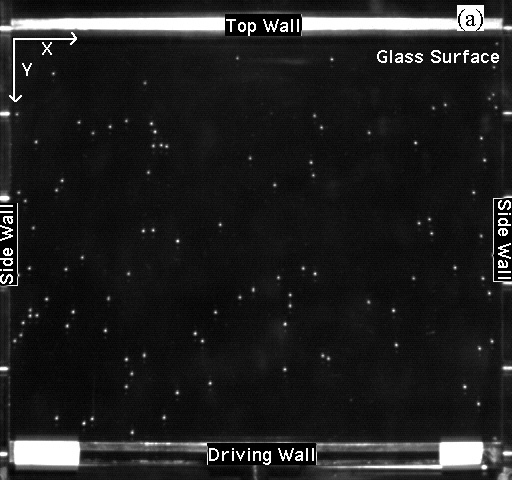Velocity distributions in granular matter
Nonlinear Physics Laboratory, Clark University

Collision statistics of driven granular materials
We present an experimental investigation of the statistical properties of spherical granular particles on an inclined plane that are excited by an oscillating side-wall. The data is obtained by high-speed imaging and particle tracking techniques. We identify all particles in the system and link their positions to form trajectories over long times. Thus, we identify particle collisions to measure the effective coefficient of restitution and find a broad distribution of values for the same impact angles. We find that the energy inelasticity can take on values greater than one, which implies that the rotational degrees play an important role in energy transfer. We also measure the distance and the time between collision events in order to directly determine the distribution of path lengths and the free times. These distributions are shown to deviate from expected theoretical forms for elastic spheres, demonstrating the inherent clustering in this system. We describe the data with a two-parameter fitting function and use it to calculated the mean free path and collision time. We find that the ratio of these values is consistent with the average velocity. The velocity distribution are observed to be strongly non-Gaussian and do not demonstrate any apparent universal behavior. We report the scaling of the second moment, which corresponds to the granular temperature, and higher order moments as a function of distance from the driving wall. Additionally, we measure long time correlation functions in both space and in the velocities to probe diffusion in a dissipative gas. Additional information can be found in "Collision statistics of driven granular materials," D.L. Blair and A. Kudrolli, cond-mat/0212336.
We study the velocity distributions of inelastic particles rolling and
bouncing inside a rectangular box. The surface on which the particles roll can be tilted to change gravitation. The velocities of individual particles are obtained using a 1000fps digital camera. The velocity distributions are found to be non-Gaussian even at low densities as shown in the image above. The distributions and a more detailed discussion can be found in Phys. Rev. E 64, 050301(R) (2001), and Phys. Rev. E. 62, R1489 (2000).
In more recent work, we observe that the velocities of the particles are correlated over large distances comparable to the system size. The distribution of the velocity strongly deviates from a Gaussian. The degree of the deviation, as measured by the kurtosis of the distribution is observed to be as much as four times the value corresponding to a Gaussian, signaling a significant breakdown of the assumptions of negligible velocity correlations in our system.
A preprint reporting these results is also avaliable.
The setup is similar to that used at Jerry Gollub's lab at Haverford to demonstrate the occurence of clusters due to inelastic collisions . Because of the formation of clusters, velocity distributions are also non-Maxwell-Boltzmann.
Currently, we are studying the pattern formation and convection of particles observed when a large number of particles (> 500) are used. We obtain the velocity field of the particles by using a quasi-2D geometry. Experiments conducted at U. Texas have shown that complex patterns can occur similar to that observed in fluids. (The first observation of wave patterns in grains and fluids was made by Michael Faraday in 1831.)
Movie of patterns using a high speed camera.
D. Blair, J. Henry, and A. Kudrolli have contributed to work discussed in this web page.
Publications
- "Collision statistics of driven granular materials," D.L. Blair and A. Kudrolli, preprint. cond-mat/0212336
- "Velocity correlations in dense granular gases," D. L. Blair and A. Kudrolli, Phys. Rev. E 64, 050301(R) (2001) cond-mat/0101015
- "Non-Gaussian velocity distributions in excited granular matter in the absence of clustering," A. Kudrolli and J. Henry, Phys. Rev. E. 62, R1489 (2000).
(preprint on cond-mat).
Comments:
Arshad Kudrolli
Department of Physics
Clark University
Worcester, MA 01610
Last modified: January 27th, 2003
